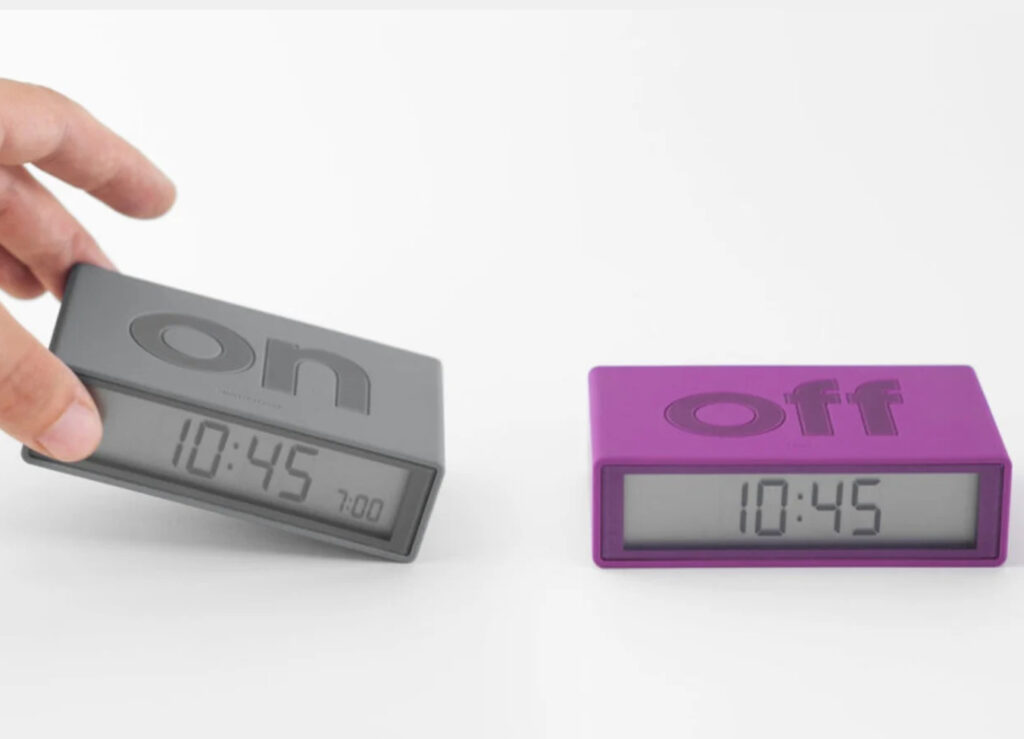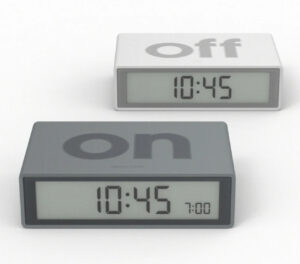The War at 7 A.M.: Snooze Culture and the Morning Struggle
For those who are not morning people, the daily skirmish between body and obligation begins before they even open their eyes. The enemy? The alarm clock. More precisely, the snooze button.
It’s become something of a cultural rite: the slap, the delay, the negotiation between sleep and responsibility. Whether it’s a glowing rectangle beside the bed or the default tones on a smartphone, the modern alarm clock is not so much a wake-up call as it is a ritualized provocation. The button says “snooze,” but the real message is: lie to yourself for nine more minutes.
Sleep scientists and psychologists warn against this cycle—interrupting your rest, confusing your brain, delaying your day. Yet still, we hit it. Because we can. Because it’s there. Because in that moment, even just five extra minutes feels like a small rebellion.
But what if the problem isn’t just us? What if it’s also the design?
The Flip Clock: Simplicity in a Stubborn World
Enter the Flip Alarm Clock by DesignWright—a product that doesn’t try to trick you out of sleep, but respects your struggle and offers a more intuitive solution.
At first glance, it looks like a minimalist block—sleek, tactile, unassuming. Its rubberized surface invites touch. Its oversized typography is crisp and clean, stating its function without apology. On one side: ON. Flip it over: OFF. That’s it.
No tiny switches. No confusing buttons. No late-night fiddling under dim light. The alarm is either set or not, visible and simple. You can literally see whether your future self will be roused in the morning or left in peace.
It’s a clock for those who hate clocks. A design that acknowledges the real pain of waking and seeks not to punish, but to guide.
DesignWright: Thinking Through Function
The Flip Clock is the brainchild of DesignWright, a London-based studio founded by brothers Adrian and Jeremy Wright. Trained in engineering and deeply grounded in industrial design, their ethos revolves around clarity, usability, and emotional intelligence in objects.
In a world oversaturated with smart gadgets, DesignWright leans the other way. Their products don’t buzz with connectivity or sync to the cloud. They operate on the principle that good design should make life simpler—not louder.
The Flip Clock exemplifies this philosophy. It doesn’t try to be more than it is. It doesn’t gamify your sleep habits or lecture you with data. It just works—quietly, effectively, with a kind of quiet charm.
Minimalism That Communicates
Design minimalism can often be a double-edged sword. Strip away too much, and you confuse the user. Prioritize aesthetics over intuition, and you risk designing for a catalog rather than real life.
But the Flip Clock balances both. Its binary design—on one side, alarm on; on the other, alarm off—is the embodiment of functional clarity. The typography isn’t elegant for elegance’s sake. It’s oversized so that you can read it when you’re half-blind with sleep.
This isn’t just minimalism. It’s communicative minimalism. Each design decision makes the clock easier to use, especially when your brain is at its least cooperative.
The Emotional Life of Objects
What makes the Flip Clock interesting isn’t just how it looks or even how it works. It’s how it feels to use.
There’s something oddly satisfying about flipping the clock to set your alarm. You’re not tapping a button or toggling a screen. You’re making a decision. You’re physically committing to the day ahead—or opting out.
That tiny gesture carries surprising emotional weight. It feels more intentional than setting an alarm on a phone. It’s tactile. Embodied. Final. There’s no ambiguity. If the clock reads “ON,” you know you’ve taken responsibility for tomorrow morning. If it reads “OFF,” you’ve chosen peace—consequences be damned.
Digital Fatigue and the Rise of Analog Charm
Why does a low-tech clock feel so refreshing in 2025?
Because the digital world has become exhausting. Phones now wake us not just with alarms but with notifications, news alerts, fitness reminders, and sleep-tracking stats. The very devices that help us fall asleep also pull us back into the day the moment we stir.
The Flip Clock offers an alternative. It separates sleep from screen time. It gives you a way to rise without immediately diving into the noise. It brings the analog back into the intimate space of your bedroom.
In doing so, it revives something deeper: a sense of presence. There’s no app. No software update. Just a small, thoughtfully designed object doing one thing well.
Design History: From Bell-Ringers to Bricks
Alarm clocks have a long and checkered history. The earliest mechanical alarms date back to the Greeks. The industrial revolution turned them into tools of punctuality and control. The 20th century added bells, buzzers, digital displays, and radio functions. And then came smartphones—flattening the whole industry into a single app.
But in all these evolutions, the user experience often got more complicated. Multiple alarm settings. Complex menus. Sleep modes. Bluetooth sync. Most clocks today are designed by engineers trying to impress other engineers.
The Flip Clock reverses that logic. It doesn’t try to do everything. It just tries to do one thing—cleanly, confidently, and without noise. In that sense, it’s not just a clock. It’s a manifesto.
Living with the Flip
What does life with the Flip Clock actually look like?
It means going to bed with less anxiety. You don’t lie there wondering if you tapped the right setting. You see it.
It means waking up without digital distractions. Your first interaction of the day is not with a glowing screen, but with a quiet block of rubber and type.
It means having a visual reminder of your intention. Seeing “ON” at night is a small nudge toward discipline. Seeing “OFF” might be a reward, a signal to rest.
And in those few moments when you’re tempted to reach for your phone? The Flip Clock waits, patiently, without judgment.
Cultural Signals: Why the Flip Clock Resonates Now
The Flip Clock isn’t just a product. It’s a signal. Of slowing down. Of choosing analog over automation. Of rejecting complexity for clarity.
In a time when even toasters have Wi-Fi, choosing a device that does less is a conscious act. It’s not anti-technology—it’s pro-intention. And in that sense, the Flip Clock taps into the same cultural current that’s made journaling, analog photography, and physical books cool again.
It’s not nostalgia. It’s survival.
Critiques and Limitations
No product is perfect. The Flip Clock has its constraints. Some versions don’t offer adjustable volume. Others lack features like gradual wake-up or multiple alarm settings.
For heavy sleepers or chaotic schedules, it may feel too simple. Some users have criticized the battery compartment as slightly tricky, and the clock is not exactly ideal for travel due to its solid, weighty feel.
But for its core audience—those seeking clarity, calm, and a break from screen addiction—the Flip delivers on its promise.
Retail Ritual: Buying the Flip Clock
The Flip Alarm Clock has become something of a cult object in design stores and concept boutiques. Available in muted palettes—greys, soft pastels, matte blacks—it’s designed to blend into spaces without vanishing completely.
Buying it feels less like acquiring a gadget and more like selecting a design artifact. It’s often wrapped in minimal packaging, accompanied by a slim manual that’s rarely needed. The experience is clean, almost ceremonial.
And perhaps that’s the point. If you can turn waking up into a ritual, you’ve already won half the day.
Impression
In the end, the Flip Alarm Clock is not about waking up. It’s about choosing how you wake up.
Do you want to begin your day in confusion, reaction, distraction? Or do you want clarity, simplicity, calm?
By reducing function to its essence, the Flip becomes more than a clock. It becomes a decision. A statement. A small, elegant way to reclaim the moment between sleep and wakefulness.
For the reluctant riser, it offers mercy. For the minimalist, it offers beauty. For all of us, it offers a reminder: the way we begin matters.
No comments yet.









